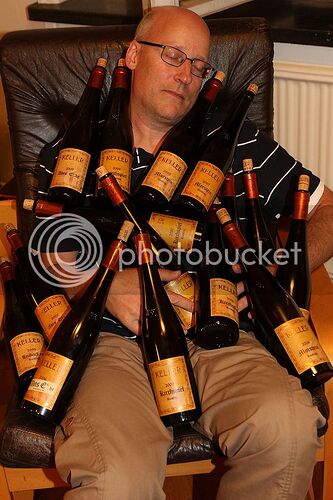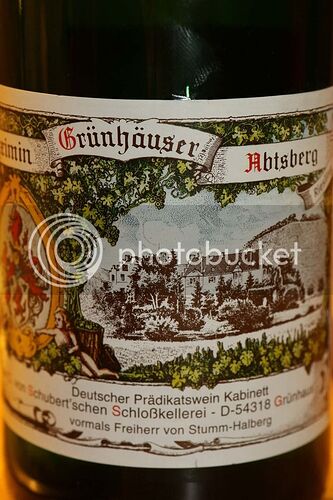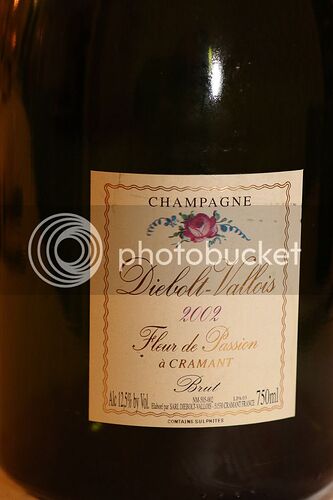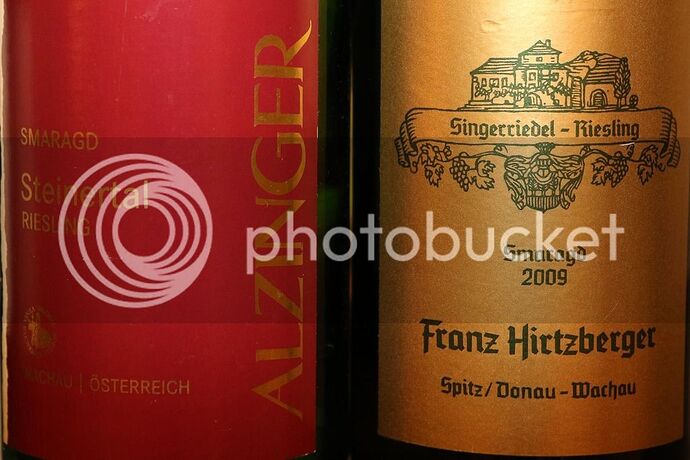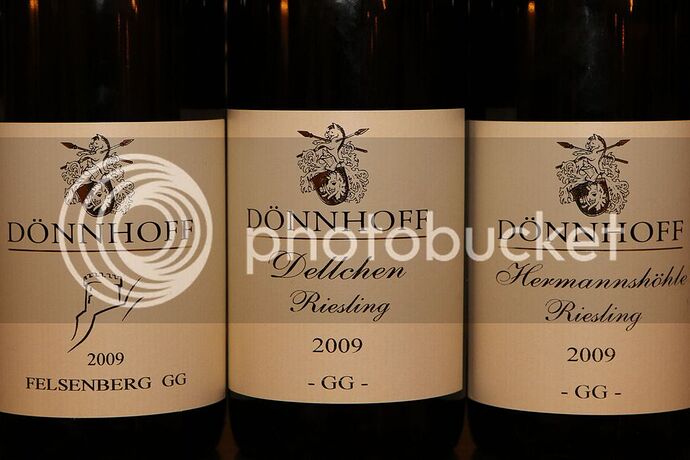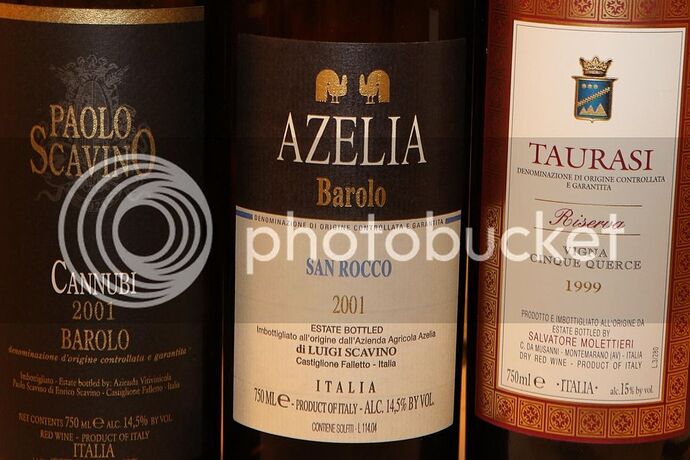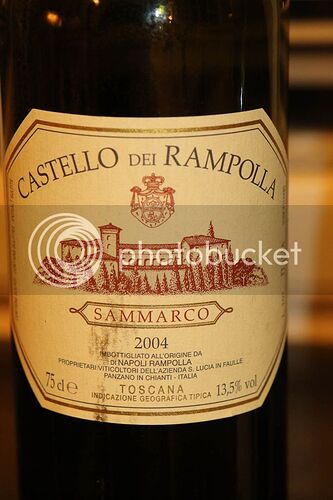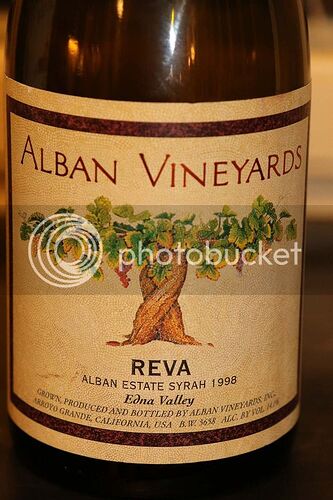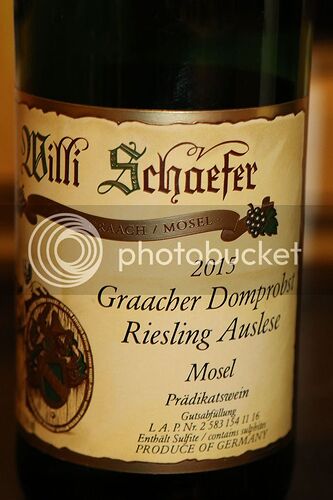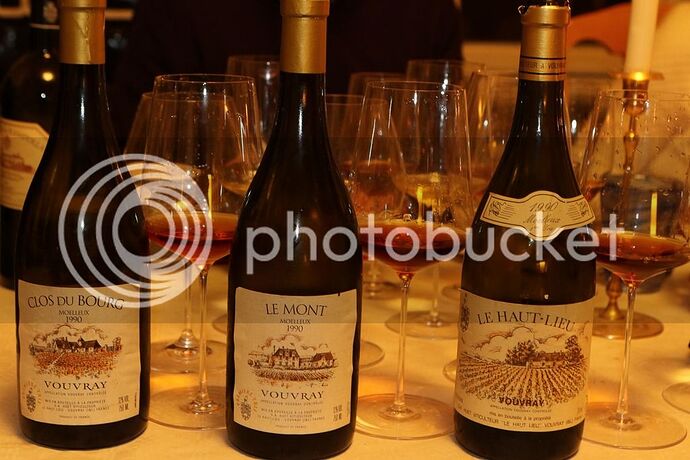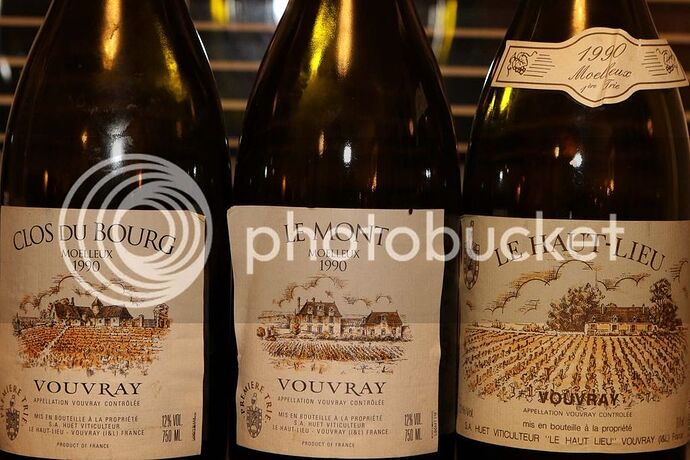I have this friend.
This is how we left him one evening when he had summoned us to a wine tasting. Should you want more details on the wines, you can find them here:
When we were all gathered (well, except for Jörgen from this board - but you may want to tell that story yourself, Jörgen, as I don’t know how to properly describe the situation… ![]() ), our host had two announcements. First, that this would be a more family-oriented dinner rather than the usual nerdy wine tasting (usually when we meet, we have the distinction between a more “gentle” and social gathering when girlfriends and even kids are invited and the more serious encounters when we gather for wine tastings not much different in nerdiness to those Comic-con meetings of Sheldon Cooper, Leonard Hofstadter, Howard Wolowitz and Rajesh Koothrappali). And second, that there will be no wines from Keller this evening.
), our host had two announcements. First, that this would be a more family-oriented dinner rather than the usual nerdy wine tasting (usually when we meet, we have the distinction between a more “gentle” and social gathering when girlfriends and even kids are invited and the more serious encounters when we gather for wine tastings not much different in nerdiness to those Comic-con meetings of Sheldon Cooper, Leonard Hofstadter, Howard Wolowitz and Rajesh Koothrappali). And second, that there will be no wines from Keller this evening.
Since the wines were served blind we were constantly guessing that it was NOT a wine from Keller, making us feel like real experts throughout the evening.
Before kicking the evening off, we were served an initial teaser just to cleanse our palate.
2015 Maximin Grünhäuser Abtsberg Riesling Kabinett
Fresh as a daisy it offers a feeling of vivid freshness with crisp slate and minerality on the palate, notes of cold pear ice-cream, fresh grapefruit, Granny smith apples, some citrus and a wonderful cleansing feeling on the finish. Truly lip-smacking as the zesty texture lures you with sharp (yet ripe) acidity. 91 points.
As this was more of a social gathering, I expected good but perhaps not truly great wines but this was surely a very good start! Then our host slowly eased on the break and suddenly went into the great wine category by pouring this champagne.
2002 Diebolt-Vallois Fleur de Passion
Very difficult NOT to like and a perennial favourite of mine. Still remember the beautiful 1996 vintage of this champagne. There’s lots to like here. Speaking of texture and over-all feeling this is about filigree elegance. Never shouting out its content but rather whispering with finesse and grace. Absolutely lovely, delicate weightlessness. There’s an intriguing white peach tone throughout the palate and if you add the glistening minerality, the ripe acidity and the feeling of fresh flowers you can probably imagine a most pleasurable drinking experience. 93 points.
I think I could down a bottle like this all to myself but since there were other guests present, who are also my friends, I had to resist the temptation to grab the bottle and make a run for it…
Not a bad start for a more “casual dinner”, I thought to myself. Little did I know that our host would pull out all the stops as the evening progressed, with the first pair of wines from Wachau, Austria.
Two Austrian Rieslings. Both from 2009, both from Wachau but very, very different…
2009 Alzinger Steinertal Riesling Smaragd
To me, the winner of the two Austrians. Compared to their German compadres, this is more voluptuous and rich in texture, with a slight bitterness towards the finish that actually makes the wine more complex and interesting. Like a succculent cactus, almost some beewax towards the finish which makes for an intriguing contrast compared to the mix of cool fruits like pear and grapes but also some tropical lime and papaya. Above all, there this lovely stream of liquid stone that invigorates the palate. Wines like this are fun because to the constantly changing impressions while sipping. Lots of different spices playing on your tongue and an interesting balancing act of richness and power yet lovely intensity, makes this a no-brainer. 93 points.
2009 Hirtzberger Singerriedel Riesling Smaragd
Initially a “warning”… This is a divider. Those of you who really enjoy rich, fat, powerful Austrian Riesling with a pronounced dried botrytis note, will love this wines. Those of you with a more “classic”/German palate, will feel it’s far too much. This is a “lot of wine” on the palate. Rich, viscous, spicy and almost “oily” in character as it announces its powerful presence on the palate. You don’t drink this for the filigree feeling of eternal lightness but for the power, richness and deep complexity. Probably harvested very late in autumn, the ripe, probably botrytized grapes, make their mark on the wine and this is my prediction - right now it still works but with further age I suspect the dried fruit/botrytis tone in the wine will take away lots of the freshness that is today balancing the richer parts of the wine. I remember having the 2004 some time ago and it was clearly a difference between wines that had been picked without botrytis and those with. I liked the former much more but I admit the juicy richness today still works for me. However, I wouldn’t save these wines for long. 92 points.
The difference with these more opulent styles of Riesling compared to “home sweet home” in my Riesling World (Germany), became even more evident as our host poured a trio of white wines that were simply brilliant. Actually, the white peppar and spiciness in the last one made me guess it was another Austrian but I should have focued on the mindboggling oscillation of energy, power and featherlike features to identify it as a German Riesling (drinking wines served blind can sometimes be a humiliating experience…).
This trio was simply brilliant and had there not been so many other wines on offer I’d be happy to just draw back in my chair and focus on these all night long.
As you see, fun and educational. Fun to taste another set of 2009s and fun also because they are from the same producer and the vineyards…well, it’s a quick walk between them. They are that close. What a lovely comparison it was! And such a rare treat to taste these wines side by side.
2009 Dönnhoff Schlossböckelheimer “Felsentürmchen” Felsenberg Riesling Grosses Gewächs
Let it be known that Helmut Dönnhoff has claimed that he will give away bottles to any native English-speaking wine lover who arrives at his doorstep and pronounces this wine correctly. ![]() Hardly a sip needs to be stolen from the glass until you’re certain of being in the presence of greatness. Liquid melted rock, yes, really melted s.t.o.n.e flows over your tongue with delicate pureness and intensity and yet, forget about power - this is all about balance and lightness. So utterly refreshing on the palate as the grapefruit mixed with (mostly) white and yellow peach mix with a sensation that could best be described as those blood-red apples with the fruit as white as the cliffs of Dover. Lovely up-lift, lovely tension and a lip-smacking finish make this a most rewarding wine experience. 93 points.
Hardly a sip needs to be stolen from the glass until you’re certain of being in the presence of greatness. Liquid melted rock, yes, really melted s.t.o.n.e flows over your tongue with delicate pureness and intensity and yet, forget about power - this is all about balance and lightness. So utterly refreshing on the palate as the grapefruit mixed with (mostly) white and yellow peach mix with a sensation that could best be described as those blood-red apples with the fruit as white as the cliffs of Dover. Lovely up-lift, lovely tension and a lip-smacking finish make this a most rewarding wine experience. 93 points.
2009 Dönnhoff Norheimer Dellchen Riesling Grosses Gewächs
The winner of the pack, in my opinion. We had a discussion about this one and it seems we were all in agreement. Imagine a crystal-clear spring creek at high mountain altitude, just as the snow has begun its inevitable melting phase and the water is as transparent as it can get. Look through the water and notice the roudly polished pebbles of stone lying at the bottom of the creek. The sun is shining, it’s still cold outside and if you grab some water with your hand you are treated to the most wonderful, fresh, crystalline and ice-cold experience - a reminder that plain water can be so damn good sometimes. There you have it. That’s what this wine is all about. We discussed the possibility that no grapes were used to produce this wine - only melted stone pebbles. It’s mineralic, it’s a tad salty, totally transparent and above all, it vibrates from zesty freshness. Everything seems to be in place; the oscillating and ripe acidity, the sparkling minerality and that pitch-perfect balance in a totally weightless package. Bravo! 95 points.
2009 Dönnhoff Niederhäuser Hermannshöhle Riesling Grosses Gewächs
Clearly deeper and more complex than the wine above, with a silky texture and more spicy notes - lots of spices in fact - and the sheer brute power amid the similar featherweight style of the previous wine. I should have guessed but the white pepper and the richness pointed me to another Wachau guess but it was obviously wrong as it turned out to be the flagship dry wine from Dönnhoff. Dellchen seems in a more balanced state while I would argue that the Hermannshöhle is still searching for that optimal sweet-spot. It’s rather astonishing that a white wine can be this complex and spicy, have this texture of brute power yet retain such a teasing lightness and transparency. Simply lovely. 94+ points.
I would have been happy to stay with these wines througout the evening and just enjoyed one sip after another to see how the wines would evolve but our host had other plans for us and asked us to have three glasses handy for red wines.
Oh yes, despite the Angst of not having more time to focus on the Dönnhoff Trio, these red wines (all served blind) were quite quaffable too.
What a GREAT lineup! Again! No wonder I had a big smile on my face already from sipping on the first wine.
2001 Scavino Barolo Cannubi
Already before lifting the first glass I hear another friend and member iof Barolo Boys Stockholm, mumbling to himself. “Ahhh, home again”. I knew what THAT meant! Home sweet home…to us, it’s bella Langa. And obviously I was to expect a Barolo in my glass. And sure enough, immediately from the glass these LOVELY aromas of licorice, chocolate, cherries, roses, spices and truffles. I asked my fellow diners: “WHY do we even drink anything else but this!?”. Then someone pointed to the bottles of German Riesling and oh well, that was a reminder that there is plenty of wine candy around the world to enjoy. But wait, I’m not finished yet about the wine. What strikes me most is it’s vibrant mineralic core, with iron and blood in the middle and the softer fruit wrapped around on the outside. Again a wine with energy but this time a red one. On the finish…it’s simply noble, delicate and utterly balanced with tannins perfectly integrated at this stage. A prime candidate for the now extinct IPOB! 95+ points. And above all…it feels YOUNG! This wine would be extremely fun to open again in five and ten years from now. And twenty. And… ![]()
2001 Azelia Barolo San Rocco
Ahhh, again this feeling of home sweet home. I’m just about to gather the other members of Barolo Boys Stockholm to plan our next trip to Langa. This is a bit darker in mouthfeel and texture, with notes of smoke, darker cherries, a lovely mineralic feeling here too (but not as perfectly integrated as in the Cannubi above) and sweet tannins. I bit of a mixture here as you feel how sublime the components in this wine wrap around itself, suggesting a mature wine but don’t let that fool you - there’s plenty of energy and this wine too feels…young! Wow. So when I’ll hit the 100+ mark, I’ll probably be craving for some Barolo from the this period. All in all, simply a delicious treat to your senses. 94+ points. The cousins to the Scavinos did well here. By the way - what a special corner just beside the road here. Scavino, Azelia, Brovia. Come to Papa!
1999 Molettieri Taurasi Vigna Cinque Querce Riserva
"Ok, so what IS this??", we wondered when sipping on this intriguing wine. My fellow Barolo Boys member across the dinner table muttered “Aglianico?”. I wasn’t sure, could it be somewhere in California? Southern Rhone? I should have listened to my friend across the table, it’s 100% Aglianico and what a fun wine experience! Apparently the most traditional kind of producer in the Taurasi region, it offers a mixture of sweet cherries, Asian spices, mushrooms drenched in soy sauce, plums and olive tapenade. It’s plush, voluptuous, dense, firm in the middle and simply gorgeous. Same goes for this one as was said about the other wines; I would have loved to just stick to this one and followed its evolution through the evening. Because that’s what you notice when you go back to the wine - seems to hide new layers each time. Some more black cherries, then suddenly some bitter chocolate, followed by tar and more spices. Again, please give me a case and allow me to follow this the coming years just to see how it will evolve. 93+ points. We agreed on thing - this region deserves a visit so anyone out there who has some hints and suggestions on whom to visit and where to eat, please let us know.
So this little “casual dinner” with friends and their families seemed to have turned out into a much more wine-focused and nerdy gathering after all. I would have been satisfied to just finish the evening here but oh no-no, our host wouldn’t have any of that and pulled the cork of two new reds, the first one being this lovely Tuscan Stallion.
You’ve guessed it… The next day? Please don’t ask. I know I’m supposed to be spitting but this evening it was almost impossible. So much delicious nectar in the glasses. It’s impossible to resist.
Many of us around the table have been visiting Casttello dei Rampolla frequently and enjoyed the company of Maurizia and her fabulous wines so it was a welcome reminder of how utterly delicious international grapes can thrive in the heartland of Tuscany. The small village of Panzano dies indeed produce some remarkable Italian gems (hint: Flaccianello).
2004 Castello dei Rampolla Sammarco
Lovely from the very first sip with chocolate, cassis and dark cherries hinting the Cabernet Sauvignon while still retaining that Italian feeling with minerality and that dusty Italian acidity and texture that makes you look towards Italy rather than any other country, despite the obvious Cabernet notes. It has a nice grip; with grip meaning both the acidity, the firm tannins and rich dark fruit. When these characteristics are mixed with spices and some herbs, you get a wonderful drinking experience. And as the perfect specimens of Baroli above, this wine feels…young. Wonderful to drink now but will surely last for a long, long time. 93 points.
Same comment here as so many times previously - I could have stayed with this wine all evening and be happy about it. However, our host thought there’s not enough wine on the table (he was always serving them blind) so opened yet another bottle.
1998 Alban Vineyards Reva Syrah (tasted this very evening)
Not knowing what the wine was, my first impression was just one big…WOW! There were so many things going on here it was difficult to sort out all the different sensory impressions. There’s the grilled meat, wait, that’s not enough - let’s throw in some rosemary herbs. Now we’re getting somewhere. But what’s oozing up in the middle of that ultra-dark cool blackberries, dark bitter chocolate and roasted meat - it’s actually dripping with bacon fat. At first I pushed away the glass and question if the bacon aromas really came from the wine and not from the kitchen where a meat stew was being prepared but no, it actually comes from the glass. There is so utterly much to like here. The tension - literally tension in the wine, the energy, the mineralic core, the wonderful lightness despite the rich, powerful fruit. To be honest, I guessed this must be a northern Rhone Syrah of the highest level but it turned out to be this old masterpiece from John Alban in Edna Valley. This wine was simply irresistible and played a major role in my not so productive the-day-after, when I was supposed to work but was instead completely exhausted - in a good way. I wrote my score behind the tasting not and look across the table to see what one of my friends had written. Apparently we stopped at the very same score. 98 points. While still having dinner I was actually mumbling that I should have scored it 99, to further stress the sheer delightness of this wine. Not that it would matter much - I think you’ve gotten the idea. This is simply a superb wine.
I’ve had the fortune to visit John Alban on two occasions and also had the fortune to spend some time with him at the Rhone Rangers celebration (Hospice) in Paso Robles. Impressions from the last encounter is still in the writing back-log but I can at least share the reason why I met with Jon the very first time, many, many moon cycles ago. The reason was that I wrote him a mail and asked to see him. And the reason for writing him was that I had tasted this very wine (by now a long time ago!). Here’s my impression of this wine when it was quite young.
1998 Alban Estate Reva Vineyard Syrah
A leap in quality here. More Rhone than Barossa and it turns out to be California instead. Wonderful nose of spices, dark fruit like black cherries those lovely patches of bacon and smoke that I like so much. And no perfect wine could be without the most important component: licorice! Concentrated fruit on the palate, even with my oak-blindness I could agree that this has a lot of vanilla-scented oak (but I like it!). Well-integrated tannins seemingly in balance with all other components, sweet fruit and a long, long, full throttle finish that keeps you smiling. My first experience with Alban and hopefully not the last. This one has a brilliant future. Immensely impressive. 95+ points.
So apparently a very good first start with Alban Vineyards but wait, there’s more… This is what I wrote a few days after tasting the wine.
“An interesting story I cannot help but to share with you. Some tiny fractions of each wine remained in huge 3 litre decanters after the tasting. TWO days later I returned to collect the empty bottles (the wine tasting was held at my mother’s place). There remained enough wine in three of the decanters to fill about 40% of an ordinary Riedel glass. The wines were the 1999 Greenock Creek – Creek Block Shiraz, the 1995 Guigal Côte-Rotie La Turque and the 1998 Alban Estate Reva Vineyard Syrah. None of the wines exhibited any oxidation whatsoever. The salinity in the Creek Block had vanished and this was now a typical fat Aussie Shiraz. The La Turque was as good as before. But something had happened to the Alban Reva Syrah. It had developed immensely. With air this one had propelled into a different league (and mind you, it received quite positive marks already from the beginning). The nose, the balance, the finish, everything was perfect. I kept mumbling, quite loudly, in total disbelief, but I couldn’t prevent myself from repeatedly saying things like Wow! Perfect! Astonishing! Ladies and Gentlemen, there’s always a first time. 100 points. There you have it.”
48 hours of air completely changed this wine. The only awkward thing with this sensational discovery two days later was that I happened to have both my mother and my - then - fiancée at the table. But…I must admit, I didn’t “see” them. Or heard them. All I had was this tunnel-like vision, completely zooming in and focusing on this astonishing wine - my first 100-point red wine - everything else, including my mother and my fiancée were just something blurry in the peripheral of my vision. Funny enough, we never married (hum…) but at least John Alban had no choice but to invite me for a visit after I wrote him to tell what had happened. ![]()
While clinging to the glass of Alban Reva as if there was no tomorrow, our host announced that it was enough already with red wines today! (Although I would argue that he didn’t quite keep his promise given the colour of the last three wines…) It was obviously time for something sweeter but before we could enter into the true dessert wine area, we apparently needed something to cleanse our palates and this (below) was his choice to prepare us for the finale.
2015 Willi Schaefer Graacher Domprobst Riesling Auslese AP #11
What can you say about a wine like this? It’s sheer world-class brilliance in a glass and the only question is how high to score it. What makes a wine like this the most impressive in my book, is that it could as well fit into a dry, semi-dry or even slightly sweet category. This sweet-sour-salty combination with waves of flavours splashing in towards your palate with ever-changing impressions, makes you just wanting to stand there in the middle of the waves as the aromas keep flushing you with new characteristics for each sip. At one occasion it feels almost dry with smoky, salty slate impressions while the next moment reminds you of transparent liquid stones only to effortlessly metamorphose into pear, white peach, lime and minty flavours. How can I describe it more? It’s electric. Racy. Pure. Totally transparent and with utter finesse. 95+ points. Probably underrated but I’m still having the fresh experience of the Alban Reva in my thoughts which might somewhat cloud my judgement of this equally brilliant wine.
Then it was time to end with something sweet in our glasses and as previously mentioned, I have issues with our host and his claim that we should now focus on WHITE wines. Sure enough, it’s all Chenin blanc but still… Look at the photo below and you’ll get my point. Visually, it felt like a red wine tasting.
There’s a long story about this particular producer and our (meaning: many of us around the table) history with their wines. For starter, we are often teasing our host for the astonishing fact that he seems to be the owner of 300+ bottles of Huet. I think I might have a case, as a comparison… But who’s complaining!? Since we’re all beneficiaries of him having this great collection. Where did this passion for Huet and the sweet Chenin blancs from the Loire Valley emerge? We both read a certain book you might be familiar to: Parker’s Wine Buying’s Guide. That’s where our host and myself read about these wines for the first time and made us visit the wine region and experience its wines. Huet and Baumard came out on top when we compared impressions and over the years we have bought, shared and enjoyed many different vintages from these excellent producers. However… The wines have always been…white. Chenin BLANC, you know. Until that day when we for the first time opened and tasted a sweet Huet from one particular vintage: 1990. We were quite perplexed when we poured the wine and saw it was…red. Or actually, luminously orange-golden, to be more precise. Why luminously? It has that special character that makes it almost glow in the glass, as if there some sort of nuclear fusion going on inside the glass, turning into a red dwarf sun. Our first thought was of course that it had suffered some heat damage or that something was wrong with the cork, but the cork looked pristine and the wine TASTED absolutely gorgeous! We just couldn’t believe how utterly mind-boggling delicious the wine was, scrambling for words to best describe the brilliance and having no other means of numerically show how much pleasure was derived from these wines other than giving them a perfect 100 points. While getting more and more familiar to Huet’s wines we have over the years tasted many excellent vintages such as the 1947, 1959, 1989, 1990 and some younger first class vintages but our discovery was that all the other wines were basically “white” while the 1990s were always…red. We did of course raise this topic when visiting the estate and the answer was they too had realised that this vintage behaved differently but they were not sure why 1990 of all vintages suddenly turned red in colour.
Over the years we have downed many 1990s and mostly been speechless from the tremendous quality of these wines, while each time admiring the red colour. Most of the times, Le Mont was the one from the trio that came out on top and occasionally Clos du Bourg or Le Haut-Lieu came out swinging with perfect bottles. We soon included another friend and wine aficionado into our little “secret” and he too was as mesmerised by these wines as we were. This is an example from his own words (and impressions):
“This is my “most” perfect wine. Tasted a total of 9 times, and scoring perfect no less than 7 times (the other 2 times - 96 and 98p - what a bummer! ![]() ). But the points are not important, the wine is. And this is a ravishing creature. The Le Haut-Lieu and Clos du Bourg is also impressive in the 1990 vintage, but Le Mont takes it to another level completely.”
). But the points are not important, the wine is. And this is a ravishing creature. The Le Haut-Lieu and Clos du Bourg is also impressive in the 1990 vintage, but Le Mont takes it to another level completely.”
1990 Vouvray Le Mont Moelleux 1er Trie, Huet
The depth of this beauty is amazing, you never seem to get to the bottom of its perfect nose. But you get loads and loads of dried orange peels, oli cloth, rhubarb, wet earth, toasted almonds, dried honey and much, much more. Racy, potent and ethereal. Manage to be hedonistic sweet and intellectual aristocratic at the same time. The taste is so wonderful that words really can’t do justice to it. It just flows effortless over the tongue and you notice the sweetness, the structure, the weight and the cleansing acidity, but it is an entity that goes beyond description. Just brilliant. Perfection in a glass. 100 points.
So all in all, we obviously have some fondness for these sweet Loire treasures. Enough said! Let’s get over to how the wines actuaully tasted this evening.
1990 Huet Clos du Bourg Moelleux 1er Trie
Yepp, for sure… It’s going to be one of those evenings. When you just take a sip and immediately realise you need to sit down and just contemplate for ten minutes before evening thinking about turning to the next wine in line. It’s that good. Minty freshness, energetic tension, delightful orange peel, apricot, blood-orange and red peaches. It’s fresh as a daisy, sappy, vibrating and simply delicious. I almost feel hesitant to report on these wines because we don’t really wish for any more competition in sourcing these wines from the market. But hey, the whole concept of wines is sharing so… I guess what impresses so much with these type of wines is the combination of depth and concentration while still keeping that buoyant levity of freshness and crispy intensity. It could as well be summarised as simply: tension. Like an extended rubber band, ready to suddenly retract to ease that particular tension. Simply astonishingly delicious. 96 points. I guess what I did next is a sign of you getting to know someone quite well, wine-wise. I looked across the table to my friend and said: “I know how you have scored this wine: 96 points”. I admit, it’s a bold statement but he raised his tasting note book and showed me the number at the bottom of the page: 96 points. ![]()
1990 Huet Le Mont Moelleux 1er Trie
Le Mont has mostly come out on top when comparing this trio side by side and indeed, the same thing happened tonight. As there is little difference (but some infinitely small nuances) between these wines I could as well describe Le Mont the same way I did Clos du Bourg. But…to get a feeling for what’s different and what could possibly be the reason for assigning this wine a higher score, the most noticeably difference is there is even greater depth in the Le Mont. Deeper layers of spices and fruit but even more, this wine tells the story even better why these TYPE of wines are such a thrilling wine experience. To find the core reason you need to focus on the intensity and ask yourself how you could best describe it when coupled to the sweetness because that, the sweetness itself, is a risk to any wine, that it somehow clouds the tension and makes it a little too cloying to reach the Olympic heights. What Le Mont so clearly displays is how the pronounced sweetness is trapped inside a wall of oscillating acidity and crystalline minerality that cuts through the palate like a Hattori Hanso samurai sword. You have it all in this wine, the featherlike filigree, totally transparent finesse, vivid crystalline brilliance, shining intensity…again, easiest summarised with one word: tension. Powerful, yet polished silk. Brutal, yet light as a feather. 99 points. And you’ve probably guessed it; I looked across the table to my friend and said: “I know how you have scored this wine: 99 points”. He raised his tasting note book and showed me the number at the bottom of the page: 99 points. Apparently we seem to be fine-tuned when it comes to these utterly astonishing wine gems.
1990 Huet Le Haut-Lieu Moelleux 1er Trie
So how to describe the Le Haut-Lieu? It’s somewhere in-between. Not as prolific mineralic as the Clos du Bourg but with the same intensity and utter balance. Here the apricot and peaches are a little more pronounced but never gives way to the slightest attempt of making this cloying in any sense. It’s astonishingly balanced and persistent and in total harmony. Whether you prefer this one or the other two will at the end of the day surely just be a question of personal taste. They are all brilliant jewels in the wine world. 97 points. Would you believe me if I said I looked across the table to my friend and said: “I know how you have scored this wine: 97 points”. He raised his tasting note book and showed me the number at the bottom of the page: 97 points. Again fine-tuned and this mirror similarity of palates became even more pronounced as we recently descended upon Langa to taste some remarkable Baroli but that’s a different post.
Here endeth my impressions from a most rewarding dinner and wine tasting.
Thanks for listening.
